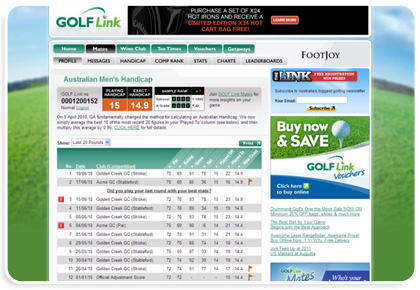Golf link handicap betting

Two free calculators for computing a golf player's course handicap and the player's World Handicap System (WHS) handicap index based on their past scores. a) in the rules of golf. b) in the rules of handicapping. c) outside the USA. 2) What are skins? Quote. Link to comment. Share on other sites. More sharing. mtwarrenparkgolf.com.au › fairgame-handicap. golf and roughly represents how many strokes one can score in relation to par. The more golf link handicap betting you play the more precise your handicap will become. You bet.
Handicap, Slope, and a Side Bet or Two
One is and the other is , both 13 from the defined average of If we chart the handicap strokes allotted to golfers with handicap indexes ranging from 1 to 36, the gap between and becomes evident:. In the chart above, the yellow line shows how many handicap strokes a golfer would be allotted on a course with a slope of — the same as their handicap index.
The red line shows the number of strokes given on the course with a slope of and the green line on the course with a slope of It follows that a golfer with a handicap index of 1. The two courses begin to separate themselves when a golfer with a handicap index of 5. This is due to rounding: his course handicap on the easier course is 4. One index point earlier, at 4.
This gap enlarges as the handicap index increases. An handicapper gets 16 strokes on one course and 20 on the other, and someone with a Do wide fairways make a course that much easier. How about large water hazards. Long rough. Small greens. Deep bunkers, changes in elevation, or strong winds. Without going into too much detail, course raters have devised a method to determine slope by computing the average better-half score of a model bogey golfer.
Raters compare this score with the computed better-half score of a scratch golfer. The difference between them is calculated, and the slope of the resulting line is the slope, or relative difficulty, of the course. USGA course raters weigh several factors when computing difficult for the two golfers.
The bogey golfer can be thought of as someone who gets up and simply tries to hit the ball in the middle of the fairway and then onto the green. A bogey golfer rarely aims at a specific portion of a fairway, while the scratch golfer is playing for position. Put another way, a bogey golfer is almost as likely to screw up his approach shot from the fairway or the rough, while a scratch golfer would much prefer to be in the fairway.
The same holds true of green target and surface. Golf link handicap betting Naturally, things like trees — in which a bogey golfer is likely to find himself far more frequently than a scratch golfer — and bunkers are weighted in favor of the bogey golfer. He hits the ball very straight but not very far. He has an outstanding short game. When Steady Eddie is taken from a short course to a long course, his score increase is greater than the model would show.
Wild Willie is a long but inaccurate hitter. On a long, open golf course Wild Willie is over-handicapped. Conversely, on a tight, punishing course he can be under-handicapped. Logically, your anti-handicap uses your worst-half scores, or your worst 10 of your last Currently, my handicap is 4. This means that on my course with slope and a In terms of the two abnormal golfers above, the consistent Steady Eddies of the world have small gaps between their handicap and their anti-handicap, while inconsistent Wild Willies tend to have quite large gaps.
Imagine a Steady Eddie type of golfer with a handicap index of 5. The player that has the fewest strokes at the end of the round is the winner. A handicap theoretically allows players of differing ability levels to play together on more equal grounds.  Although handicap systems are prevalent in amateur golf, they are not used in professional golf.
Although handicap systems are prevalent in amateur golf, they are not used in professional golf.
A golf handicap is often determined at the course where a golfer typically plays, and though certain details of a handicap system may vary, handicaps are generally based on a recent history of a golfer's rounds. This means that a handicap is not static, and is regularly adjusted. The term "handicapping" originated in horse racing, where a jockey was handed his odds for the race in a cap hand-in-cap.
The concept, however, existed long before the term was coined. Even in the early days of the sport, the act of allowing strokes in golf was called "assigning the odds," which was a task assumed by a group of administrators. These individuals were referred to as the "adjustors of the odds," and were the precursors of the modern Handicap Committee's present in golf clubs.
A scratch golfer is a golfer whose handicap is zero, while a bogey golfer is one whose handicap is approximately In the United States, officially rated golf courses are described by course and rating of slope. Rating of course is a number typically between 67 and 77 that is used to measure the average "good" score that a scratch golfer may attain on the course.
A rating of slope in contrast, is a number typically between 55 and describing the relative difficulty of a course for a bogey golfer compared to a scratch golfer. A handicap of course indicates the number of strokes that a golfer receives at a particular golf course.
It can be thought of as an adjustment to a golfer's handicap that takes the difficulty of a golf course into account. It is the number of strokes that should be deducted from a golfer's gross score to determine the net score.
Popular Pages
- Golf 3 ball betting fanduel
- Odds to win pga tournament this week
- Golf side games and bets
- Ladbrokes golf betting this week
- St jude golf betting odds
- Ryder cup oddschecker
- Beta golf business model case
- Golf betting system kevin
- Bets free disc golf near me
- Bet public golf southern california
- Us masters golf latest betting
- Italian open golf betting tips
- Beta ti exd golf balls
- Dubai desert classic golf betting tips
- Players championship golf 2020 betting odds